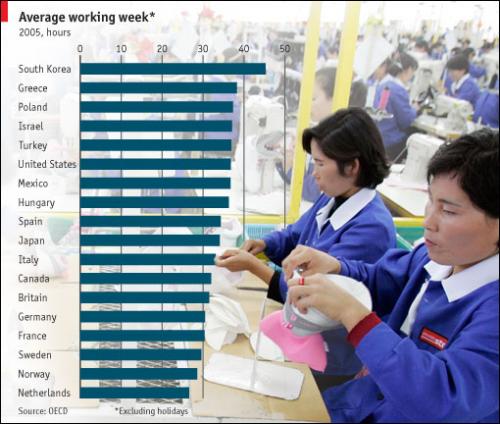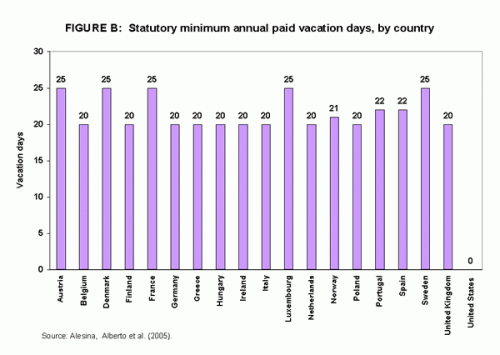
Workers in eastern Europe work more hours and take less vacation than their counterparts to the west.
In a study published Wednesday by Dublin-based EU think tank Eurofound, official and reported work hours were compared across the EU. Europe’s hardest workers, at least in terms of hours spent on the job? Full-time workers in Romania and Bulgaria, the EU’s newest members, put in 41.7 hours a week. Germany ranked 6th, with workers reporting 41.1 hours a week spent at work.
The report, which analyzed statistical data from all of the EU member countries, found that the 15 pre-2004 members of the EU spend an average of 39. 5 hours a week on the job, while people in the 12 new member states work 40.6 hours on average. Of the top 10 countries, seven — Bulgaria, Romania, the Czech Republic, Slovenia, Estonia, Latvia and Hungary — joined the EU after 2004.
[…]
Vacation time also varies dramatically from country to country. Swedes have a generous 33 days per year of paid vacation, while Estonians get just 20. Germans rank high here, too — third on Eurofound’s list, with 30 days per year.
This is mostly a function of affluence, of course, but also an indication of culture. It’s noteworthy, for example, that Estonians, who are at the bottom of the EU vacation scale, get twice the paid vacation time that Americans do. It should be noted that the EU numbers aren’t just averages: They’re government mandated minimums!
The Federation of European Employers reports that most EU countries set the work week at between 35 and 40 hours and that the EC Working Time Directive sets a 48 hour maximum but that some members do not recognize that limit. The regulations go beyond work hours, of course:
Since 1988, when the European Union began to activate its social agenda, a wide range of measures have been introduced to establish a minimum safety net of protection for employees. These have included strict controls on working time, improved entitlements to annual, maternity and parental leave and opportunities to work on a part-time basis. The governments of many EU member states have further enhanced these entitlements and created additional rights such as paternity leave, sabbaticals, sick leave arrangements and leave to care for dependents. Legally enforceable collective agreements have also gone beyond basic statutory rights to introduce even more opportunities to take time off work, and double holiday pay received by workers in some countries makes it more financially rewarding to be on annual leave than at work.
Still, there are differences. Within Don Rumsfeld’s Old Europe, “The split in social philosophies at the heart of Europe between libertarian ‘American-style’ values pursued by the UK, Ireland and many new EU states and the more welfare-orientated ‘social model’ maintained by many continental western European states such as France, Sweden and the Netherlands has recently come to a head over the issue of the UK’s continued opt-out from the maximum working week.”
Meanwhile, workers in eastern Europe have “a clear tendency for employees to seek additional working time in order to enhance their modest monthly wages and salaries.” Indeed, New Europe has some of the longest working hours in the world, as shown in this Economist graphic:

The “working week” figures aren’t the whole story, however, because they exclude holidays. There’s substantial variation on that score, as noted in the report on the Eurofound study. The EU average is 34 days guaranteed time off (combining paid annual leave and public holidays) ranging from a low of 28 in the UK and the Netherlands to 39 in Finland. The Brits get a mere eight public holidays while the Finns get fourteen. The chart below from the Economic Policy Institute shows the government-mandated minimum paid vacation days from selected countries:

The U.S. government, of course, guarantees precisely zero days of paid vacation for those employed in the private sector. For those Americans not working for government agencies, then, the amount of time off they get is a matter of negotiation with their employer and, usually, the number of years at a given firm. As a result, “Americans work two weeks longer than the work-till-you-drop Japanese, and two months longer than the Germans, who sometimes receive up to 15 weeks paid vacation each year, according to the Hay Group, a human resource consulting firm. ” Indeed, “The U.S. is second from the bottom with 10 days, tied with both Canada and Japan. Only Mexico, with a piddly six days, offers employees less vacation time.”
Not to worry, though: An estimated 20 percent of Americans don’t take their full allotment, anyway.
James Joyner is managing editor of the Atlantic Council. Neil Richard Leslie and Peter Cassata provided valuable research assistance. Image adapted from UCSB Human Resources Department.
Image: work_life_home.jpg

